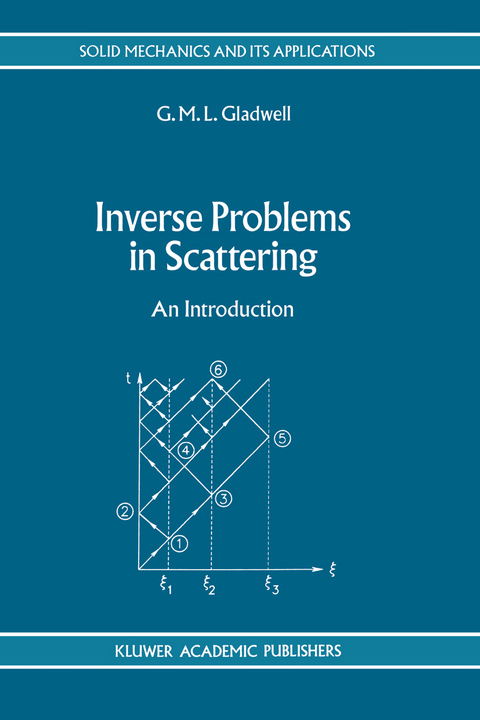
Inverse Problems in Scattering
Springer (Verlag)
978-0-7923-2478-2 (ISBN)
1 Some Simple Wave Phenomena.- 1.1 Waves.- 1.2 Generalized Functions.- 1.3 Lossless Transmission Lines.- 1.4 Waves in an Elastic Medium.- 1.5 Sound Waves.- 1.6 Reflection and Transmission of Waves.- 1.7 Standardising the Wave Equations.- 1.8 Standardised Reflection and Transmission.- 1.9 Conservation Equations.- 1.10 Difference Schemes for Wave Problems.- 1.11 Down-Up Difference Schemes.- 1.12 Causal Solutions, Green’s Functions and z-Transforms.- 2 Layer-Peeling Methods for Discrete Inverse Problems.- 2.1 Introduction.- 2.2 On the Interpretation of the Discrete Equations.- 2.3 The Impulse Response and the Propagation of the Wavefront.- 2.4 Discrete Equations for Layer-Peeling Methods.- 2.5 Some Questions.- 2.6 Functions of a Complex Variable.- 2.7 Schur’s Lemma.- 2.8 The Schur Algorithm and Downward Continuation.- 2.9 The Schur Algorithm and Toeplitz Matrices.- 2.10 Layered Media of Non-Goupillaud Type.- 3 The Inversion of Discrete Systems Using Non-Causal Solutions.- 3.1 Introduction.- 3.2 Some Simple Non-Causal Solutions.- 3.3 Claerbout’s Equation.- 3.4 Levinson’s Algorithm.- 3.5 Levinson’s Algorithm and Claerbout’s Equation.- 3.6 A Discrete Gel’fand-Levitan Equation.- 3.7 Bruckstein and Kailath’s Equation.- 3.8 Time-Sums of the Basic Solutions.- 3.9 A Discrete Gopinath-Sondhi Equation.- 3.10 Comments on the Literature.- 4 Waves in Non-Uniform Media.- 4.1 Introduction.- 4.2 Characteristics.- 4.3 Causality, Initial Value Problems and Intervals of Dependence.- 4.4 Riemann’s Representation.- 4.5 Difference Schemes for Initial-Value Problems.- 4.6 Initial-Value-Boundary-Value Problems.- 4.7 The Propagation of Singularities.- 5 The Inversion of Continuous Systems Using Causal Solutions.- 5.1 Introduction.- 5.2 Reconstruction of the Impedance.- 5.3Reconstruction of the Reflection Function.- 5.4 A Non-Linear Integral Equation for the Reflection Function.- 6 Inversion of Continuous Systems Using Non-Causal Solutions.- 6.1 Introduction.- 6.2 The Basic Solutions.- 6.3 Some General Integral Equations.- 6.4 Krein’s Integral Equation.- 6.5 The Levinson-Durbin Algorithm.- 6.6 The Linear Gel’fand Levitan Integral Equation.- 6.7 The Non-Linear Gel’fand-Levitan Equation.- 6.8 The Marchenko Integral Equation.- 6.9 The Gopinath-Sondhi Equation.- 7 An Introduction to the Inverse Scattering Problem of Quantum Theory.- 7.1 Introduction.- 7.2 Schrödinger’s Equation.- 7.3 Orthogonal Polynomials.- 7.4 The Spectral Problem for a Jacobi Matrix.- 7.5 Functions of a Complex Variable—II.- 7.6 Fourier’s Problem.- 7.7 A Finite-Difference Form of the Schrödinger Equation.- 7.8 A Finite-Difference Form of the R-Matrix Approach.- 7.9 The Determination of the Jost Function.- 7.10 The Gel’fand Levitan Procedure for Jacobi Matrices.- 7.11 The Gel’fand-Levitan Procedure.- 7.12 The Marchenko Procedure.- 7.13 Some Generalizations.- 8 The Schrödinger Equation on the Half Line.- 8.1 Introduction.- 8.2 The Schrödinger Equation on the Finite Line.- 8.3 The Spectrum for the Finite Line is Discrete.- 8.4 Schrödinger’s Equation on the Half Line: The Discrete Spectrum.- 8.5 The Regular Solution.- 8.6 The Jost Solution.- 8.7 The Jost Function and the Phase Shift.- 8.8 The Bound States.- 8.9 The Integral Representation of the Jost Function.- 8.10 The Orthogonality Relations.- 9 The Lebesque Integral.- 9.1 Introduction.- 9.2 Real and Complex Numbers.- 9.3 Metric Spaces.- 9.4 Functions and Function Spaces.- 9.5 The Riemann Integral.- 9.6 Measurable Sets and Measurable Functions.- 9.7 The Lebesgue Integral.- 9.8 Applications andProperties of the Lebesgue Integral.- 9.9 Differentiation and Integration.- 9.10 Fourier Transforms.- 10 Inverse Scattering for the Schrödinger Equation.- 10.1 Introduction.- 10.2 The Pozner-Levitan Representation of ?.- 10.3 The Gel’fand-Levitan Integral Equation.- 10.4 The Levin Representation of the Jost Solution.- 10.5 The Marchenko Integral Equation.- 10.6 Equivalence of the Equations of Gel’fand-Levitan and Marchenko.- 10.7 Conditions on the Data Leading to a Regular Potential.- References.- Index of Notations.
| Erscheint lt. Verlag | 31.10.1993 |
|---|---|
| Reihe/Serie | Solid Mechanics and Its Applications ; 23 |
| Zusatzinfo | X, 366 p. |
| Verlagsort | Dordrecht |
| Sprache | englisch |
| Maße | 160 x 240 mm |
| Themenwelt | Mathematik / Informatik ► Mathematik ► Angewandte Mathematik |
| Naturwissenschaften ► Physik / Astronomie ► Allgemeines / Lexika | |
| Naturwissenschaften ► Physik / Astronomie ► Theoretische Physik | |
| Technik | |
| ISBN-10 | 0-7923-2478-1 / 0792324781 |
| ISBN-13 | 978-0-7923-2478-2 / 9780792324782 |
| Zustand | Neuware |
| Haben Sie eine Frage zum Produkt? |
aus dem Bereich


